Introduction
The big question for the big one. Even more iPhone goodness in a
single package or a phone for the fence-sitters? To loosely quote Apple
itself, bigger isn't necessarily better. So, a niche product or the real
deal?
The iPhone 6s Plus is a second generation phablet - a breed, which Apple long refused to be associated with. It's an S-model too meaning last season's design and changes mostly under the hood.
The push for ease of use has brought about 3D touch - literally adding a sense of depth to your interaction with the smartphone. And the device's response comes from an all new Taptic engine for unrivaled feedback precision.
It is the former that accounts for the most dramatic changes the 6s Plus brings physically. The hair's breadth increase in dimensions you won't notice, but the added weight is immediately felt. And while the 4.7-inch iPhone 6s is still manageable despite the extra heft, the Plus is pushing the boundaries of portability.
Part of the growing up process is the new camera. Apple is finally
catching up with the times and now offers 12MP stills, complete with 4K
video recording - the iPhone is no longer the favorite target of mockery
from supercharged Android flagships. Double the RAM and a new, more
powerful A9 chip round up the list of changes that Apple delivered.
Key features
- Metal unibody, 7.3mm slim, 192g of weight
- LTE connectivity (Cat. 6, 300Mbps downlink)
- 5.5" 16M-color LED-backlit IPS LCD of 1,080 x 1,920px resolution, 401ppi
- 3D Touch technology recognizes force, brand new Taptic engine for better feedback
- Ion-strengthened glass, oleophobic fingerprint-resistant coating
- Dual-core 1.8 GHz Twister 64-bit CPU, PowerVR GT7600 GPU, 2GB of RAM, Apple A9 SoC
- Apple iOS 9
- 12MP F/2.2 camera with optical image stabilization, True tone LED flash, phase detection auto focus, 2160p@30fps, 1080p@30fps, @60fps and @120fps video recording, 720p video recording @120fps and 240fps
- 5MP F/2.2 front-facing camera with BSI sensor and HDR mode, 1080p@30fps video
- Comes with 16, 64, and 128GB of built-in storage
- Second-gen Touch ID fingerprint sensor built into the Home button
- Barometer sensor for tracking elevation
- 2,750mAh battery
Main disadvantages
- Heavy
- No microSD slot
- Pricey memory upgrades, 32GB version should be standard for such an expensive phone
- No user-replaceable battery
- Protruding camera lens makes the phone wobble if you don't have a case on
- NFC functionality limited to Apple Pay
- No wireless charging, an infrared port, or FM radio
- • Mediocre screen-to-body ratio
So not only did Apple make a phablet, but followed up on it,
confirming itчs committed to the big-screen experience. But who could
blame them when the Plus model of the last generation accounted for some
30% of the total iPhone 6 sales in the first 6 months of availability.
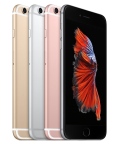
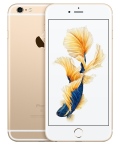
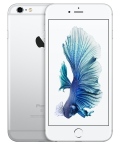
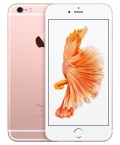
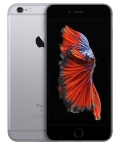
iPhone 6s Plus press images
And no, this new one isn't radically different. It's not meant to single-handedly herd compact phone users into the phablet camp. However, with public opinion now even in the iOS world gradually warming up to the idea, don't be surprised if the sales numbers of the two iPhone sizes keep converging.
But let's not get ahead of ourselves and leave these figures to the accountants. We'll stick to the review at hand, starting off with the unboxing and hardware overview.
Apple-standard retail package
The iPhone 6s Plus arrives in a plain white retail box with the phone
printed on the lid, its color reflecting the contents. The compartments
beneath the phone itself accommodate the AC adapter, rated at a lowly 1
amp, and a meter-long USB-to-Lightning cable. There also a headset
bundled, separately packaged.
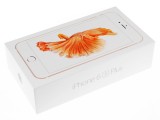

Apple iPhone 6s Plus retail package
Apple iPhone 6s Plus 360-degree spin
The iPhone 6s Plus is huge for its display diagonal, and that's
hardly a surprise considering it's pretty much the same chassis as last
year. At 158.2 x 77.9 x 7.3mm this year's Plus model didn't have to grow
as much as the compact version to accommodate the network of sensors
that enables 3D touch.
At 192g it's heavy, too heavy, perhaps. A full 20g more than the
predecessor, all thanks to the 3D touch tech apparently, the weight is
verging on becoming a burden. A solid slab of aluminum of the same
dimensions would've weighed 245g so it's almost there.
In comparison, the Galaxy S6 edge+ with its 5.7-inch display is
smaller in every direction and it's some good 39g lighter. The 5.5-inch
LG G4 is a centimeter shorter and 37g lighter. With the same display
diagonal, the Xperia Z5 Premium is 2mm narrower and 4mm shorter, but
comes close in terms of weight with 180g worth of glass and metal.
Design and handling
A lot has been said about the color of the year, and we deliberately
picked it for our Plus review unit. We would go ahead and call it pink,
but if Apple insists on Rose Gold, so be it.
One could argue that for its sheer size and weight, the iPhone 6s Plus is a man's phone. But then again, it's a better fit for a purse than a pocket for the exact same reasons.
As for the paint job, it must be the same thing that makes people want a rose gold Rolex or a pink Cadillac.
Other than the color, it's a case of "spot the differences" between the 6s Plus and the 6 Plus.

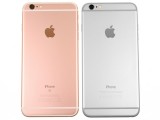
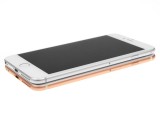
iPhone 6s Plus (left) next to the iPhone 6 Plus
Sure, it's a different grade of aluminum alloy, but show us the guy who can tell the difference just by looking. Also, just dropping the 7000-series catch phrase on every half occasion tells little of the actual mechanical properties of the specific alloy used on both of the S models, versus last season's.
Good thing then that the bending, and dropping, and flamethrowing, and whatever-crossed-your-mind tests that flooded YouTube in the past few days actually proved that the new chassis is miles ahead of the bend-prone predecessor. We appreciate the steps Apple has taken, yet can't help but wonder who failed to do their homework on the first try.
Being an S year, we know not to expect changes in design. So we'll just quietly state that a year later we haven't grown fond of the antenna strips on the back. Different color options make them more or less prominent, but they're still there - and somehow more intrusive at this size. But you might not even notice them if you keep your phone packed in a case at all times.
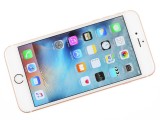

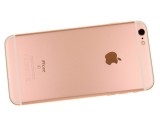
iPhone 6s Plus design
Another eye sore are the large bezels - the iPhone 6s Plus was a champ in terms of wasteful use of footprint and nothing's changed. It's the Space Grey model that will suffer the least in this respect, with its black façade successfully blending with the display. On the other three color options, our Rose Gold included, the wide white frame around the screen is a lot more obtrusive.
The craftsmanship is up to the typical Apple standards - that is to say, unlike any other. It's hard to find another smartphone on the market that just exudes luxury quite the same way that the iPhone 6s does, and with the Plus there's just more of it.
The 2.5D ion-exchange glass is a joy to swipe, with a nearly seamless joint where the glass meets the aluminum. The buttons fit snuggly in their cutouts and have very positive clicking action. It's only the SIM card tray, or rather the frame cutout, that catches the tips of your fingers spoiling the overall sense of perfection. Of course, if you deliberately examine it, and there's now viable reason why you should.
One of the greatest changes this generation is weight. Where the iPhone 6 Plus was on the heavy side of average for a 5.5-inch device, this new 6s Plus is simply massive and there's no two ways about it. At least it hasn't grown in dimensions, so it'll fit in the same pockets, just your belt will suffer. Some cases you'll be able to reuse, some not, and the softer the case material is, the higher chance you have that it will fit.
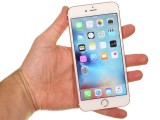

iPhone 6s Plus in the hand
You obviously can't reach the extremes with your thumb without readjusting your grip, like Apple tradition calls for. And while fumbling with the phone, you better be careful as the finely textured aluminum back is the epitome of slippery. Grab a silicone back and forget about it.
Controls
The primary mode of interaction with the iPhone - the Home button
with the Touch ID embedded inside - is where it's always been - dead
center, below the display. It's being marketed as a second-generation
Touch ID sensor, and it shows by the speed it takes it to recognize your
fingerprint.
The identification works in a heartbeat and doesn't really allow you to have a glance at the lockscreen. Taking a screenshot of the lockscreen with Touch ID enabled is virtually impossible, as the phone gives priority to unlocking over the two-button screenshot combination. Of course, that's mostly a reviewer's problem, not a user's.
Up top you'll find the earpiece flanked by the new 5MP front camera and the proximity sensor above.


Touch ID Home button • a standard arrangement on top
The new 12MP primary camera is in the old position, and sticks out by a little less than a millimeter. The front element of the lens is made of sapphire crystal, so it should be tougher than most anything it has to face in the real world. It's also colored differently, compared to the predecessor with a larger portion blacked out now.

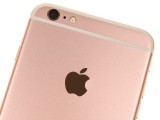
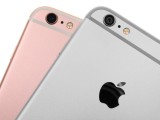
Primary camera with dual-tone dual-LED flash
Oh the right you have the power button towards the top and the SIM card tray we already mentioned. On the left, again in the top third, there's the volume rocker and the mute switch.
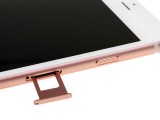


Power button and card tray • volume and mute controls
The bottom is a lot busier. The Lightning port takes center stage, a screw on each side. The speaker is to the right, while the 3.5mm jack and microphone pinhole are on the left. The top is completely bare.
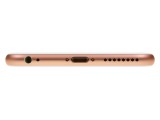
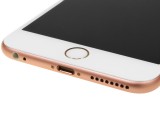
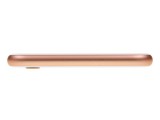
Beautiful FullHD 5.5-incher
The Apple iPhone 6s Plus has a 5.5-inch IPS LCD display with
1,080x1,920 pixels resolution for a 401ppi density - well above Retina.
Our microscope shot brings no surprises and reveals a standard RGB matrix with an equal number of red, green and blue pixels.
The iPhone 6s Plus has an even brighter display than the iPhone 6s but due to the slightly brighter blacks, the contrast ratio on both devices is quite similar 1382:1 for the iPhone 6s Plus vs. 1481:1 for the iPhone 6s. The screen is not as bright at its maximum setting as the iPhone 6 Plus but the contrast ratio is about the same as the blacks are deeper in comparison.
| Display test | 50% brightness | 100% brightness | ||||
| Black, cd/m2 | White, cd/m2 | Black, cd/m2 | White, cd/m2 | |||
| 0.10 | 148 | 1542 | 0.36 | 536 | 1481 | |
| 0.10 | 150 | 1563 | 0.43 | 590 | 1382 | |
| 0.17 | 207 | 1230 | 0.61 | 740 | 1213 | |
| 0.17 | 208 | 1197 | 0.52 | 705 | 1361 | |
| 0.00 | 183 | ∞ | - | 439 | ∞ | |
| - | - | - | - | 620 | - | |
| 0.00 | 172 | ∞ | - | 410 | ∞ | |
| - | - | - | - | 540 | - | |
| 0.09 | 108 | 1240 | 0.43 | 532 | 1238 | |
| - | - | - | 0.68 | 789 | 1158 | |
| 0.00 | 169 | ∞ | 0.00 | 367 | ∞ | |
| 0.00 | - | - | 0.00 | 560 | ∞ | |
| 0.00 | 149 | ∞ | 0.00 | 372 | ∞ | |
| 0.14 | 205 | 1435 | 0.29 | 487 | 1657 | |
| 0.16 | 180 | 1139 | 0.30 | 399 | 1334 | |
Much like with the Apple iPhone 6s, the color rendition of the screen
is generally accurate with a pretty low average deltaE of 4.1 (for the
primary colors plus black and white), and it's the reds and magentas
that show a higher than average deviation. The white is slightly on the
cooler bluish side, but nothing major and certainly not noticeable
without a reference.
As usual, display colors are a matter of personal taste and perception so if you don't need calibrated color output, you will probably be quite happy with the Apple iPhone 6s Plus screen as it is out-of-the-box.
There's a significant improvement in terms of sunlight legibility compared to the old model. The smaller models, both new and old, are still comfortably ahead. Even so, the iPhone 6s Plus has one of the highest ranking LCD panels in this test.
Apple iPhone 6s Plus battery life
The battery inside the iPhone 6s Plus has a 2,750mAh capacity, a
modest decrease from the 2,915mAh of last year's model. Apple's claim is
that the new model will last as long as the old one, and that's as
specific as it gets.
We're a lot more into precise numbers and subjected the 6s Plus to the usual battery of tests and it actually performed better than the old Plus, though with the notable exception of 3G call times. The smartphone would die on us after 16 hours, two thirds of the iPhone 6 Plus' time.
Use the phone with the display on and it scores substantially better. A full 14 hours of video playback is nothing short of exemplary, and means that when the 6 Plus calls it quits, the 6s Plus can go on for another 2 and half hours. The Samsung Galaxy S6 edge+ lasts 4 minutes shorter in this test, well within the margin of error.
Moving on to web browsing, we witness a 2 hours and forty-some
minutes better longevity for this year's model, but more importantly an
hour and a half of an advantage over the Galaxy S6 edge+.
Overall, the iPhone 6s Plus scores a combined endurance rating of 85 hours. Compare that to the 79 hours of the iPhone 6 Plus and you'll see that, indeed, the decrease in capacity hasn't adversely affected the battery life.
If anything, you'll actually get a better longevity with the new model if your usage is geared more towards surfing the web and watching videos rather than voice calls. Compared to the Galaxy S6 edge+, the differences in screen-on usage are smaller, though noticeable especially in web browsing. However, the Samsung phablet can last twice as long on voice calls, which obviously you should consider if that's your predominant use case.
If you've been paying attention, you'd have noticed that at half brightness (which is the setting we carry our battery tests on) the 6s Plus puts out less nits than the 6 Plus. That certainly helps its case, though it can't make all the difference, and improved efficiency has to account for a large part of the improvement. The phone is also perfectly usable at this setting thanks to its excellent contrast, and there's really no need to crank it up any higher unless you're outdoors in bright daylight.
Connectivity
The Apple iPhone 6s Plus comes with a host of wireless connectivity
features. It supports faster LTE Cat. 6 (up to 300Mpbs down, 50Mbps up)
and has even wider LTE coverage. Regular 2G and 3G connectivity is all
safely covered as well with a multitude of supported network bands.
The iPhone 6s Plus also supports the latest Voice over LTE (VoLTE),
HD Voice and Wi-Fi calling protocols, but those are carrier dependent
features so not everyone will enjoy them.
Compared to the iPhone 6, the 6s now upgraded Wi-Fi functionality too - it supports all the current Wi-Fi a/b/g/n/ac standards but doubles the theoretical speeds thanks to the use of a 2x2 MIMO antenna. AirPlay is the only way to wirelessly cast your screen's contents to an HDTV, but you'd need to have an Apple TV for that.
Additional local connectivity includes Bluetooth 4.2 LE. There is also support for NFC, but its functionality is only limited to Apple's region-restricted Apple Pay.
The iPhone 6s Plus uses a proprietary Lightning connector for wired
data transfers and charging. There is no support for USB On-the-go or
USB host but you can pair a Bluetooth keyboard to the phone should you
need this sort of peripheral. At least the 3.5mm jack is standard.
Apple iOS 9 - some new features, lots of potential
Sticking to its usual practices, Apple unveiled the new iOS 9 in June, but at that point it didn't cause too much excitement. Looking much like iOS 8 and bringing only a handful of new features, it didn't stay in the spotlight for long.Now, a few months later things are different - the iOS 9 biggest update wasn't mentioned at the announcement for understandable reasons - it's the support of the new 3D Touch display and the API that will be available to game and app developers. Depending on how it goes with the early adopters, this feature alone has the potential to alter the way we interact with our phones the same way the first capacitive display and the multi-touch gestures did.
The support for 3D Touch allows for another level of interaction, press the screen for a bit longer (and harder). This gets you access to extra actions and contextual options and we can't wait to see how say, game developers put that to use in the months to come. We'll get back to examining Touch ID and its impact on iOS 9 in a short while, but first let's cover the basics of the new Apple platform.
iOS 9 brings a couple of new apps - News and Notes, while also enhancing Maps with public transit support. Mail and Messages got refreshed and there's a new system font. Meanwhile Siri got smarter, while Spotlight Search expanded its reach.
Visually iOS 9 looks the same as its predecessor. All of your apps are on the homescreen, you can group them in folders and there is the familiar dock that can take up to four shortcuts. System icons, color themes and transparency - everything is like we left it in iOS 8.
The lockscreen hasn't changed much either, but it now supports Live Photo wallpapers - they are either short animations or you can use one of thoseLive Photos that the iPhone 6s duo is capable of capturing. For the animation to activate, you need to press firmly on the screen, which is somewhat counterintuitive and we doubt it will be an oft used feature as nobody would really want to hard press the screen for 3 seconds just to see their lockscreen wallpaper move a bit.





The lockscreen • The homescreen • Control Center • Notification Center
The Control Center that's pulled up from the bottom of the screen keeps the same layout of toggles, shortcuts and media controls. The Notification Center drops from the top and features the same Today and Notification tabs. There are no new widgets or notification options.
The task-switcher interface loses its webOS flat cards look and opts for a cooler 3D carousel. Unfortunately, you are still able to only see just three apps, and it takes even more scrolling so we're not quite happy with this change.

The new task manager
The iPhone 6s Plus supports quick app switching between opened apps via a Force Touch gestures. Just swipe from the far left side of the screen with a firm touch and you'll get to the app switcher. Upon choosing the app you want to go to, this gesture starts alternating your current app and the one you've selected. Say you are browsing and Facebook chatting simultaneously, you can switch between the two apps with just a firm swipe from the left. It sounds a bit complicated but it's actually quite intuitive once you try it.
The Spotlight search has been improved. You can invoke it by a downwards swipe from anywhere on the homescreen, or go to the leftmost pane. It has been updated and can now do simple calculations and conversions. It also supports finding sport scores and weather forecast information. And finally, you get shortcuts for making a call or sending a message to any of the contact results in the Spotlight searches.





The new Spotlight Search
In the absence of any form of multi-window multitasking (or, well, any multitasking), the Plus does at least have a landscape mode for the homescreen and a dual-pane layout for some of the native apps. Safari goes beyond that, rearranges its bottom control bar and places it on top around the address field, and adds another bar for quick access to tabs.
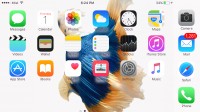
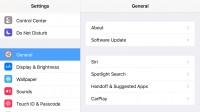
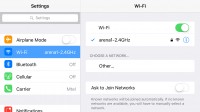
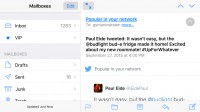


Landscape view
Siri got smarter, too. In addition to all the cool stuff the intelligent assistant could do before, it can now search through your photos and videos based on dates, locations and the album names. It supports custom reminders from things you've been searching for in Safari, Mail, Notes and Messages and it got support for public transit navigation too.


Siri can be summoned anytime by saying 'Hey, Siri'
Next, there is the new pro-active assistance available system-wide, which is more or less Apple's take on Google Now - it provides relevant information to you in advance - before you start typing something or before you leave for some place (work, home).
Finally, iOS 9 extends the overall language support for Siri, Spotlight, the predictive input, dictation support, dictionaries and spell check. Siri is now available in Austrian German, Belgian French and Norwegian, while Mexico gets its proper Spotlight support.
Predictive input is now available in Belgian French, Austrian German, Gujarati, Hindi, Hinglish, Punjabi, Mexican Spanish and Telugu. Finland and Korea get spell check. Last, but not least, dictation is now available for Belgium (Dutch and French), English for Ireland, Philippines, and South Africa, Austria (German) and Spanish for Chile and Colombia.
When it comes to predictive input, iOS 9 would gradually learn the way you type and search and would eventually become a passive yet very useful assistant. This will take off some pressure of Siri and yet make your interactions with the iPhone much easier and pleasant.
3D Touch aims to be the next big thing
Currently 3D Touch gestures are available only on selected system app. You can use it on the lockscreen, the homescreen and within apps. We already talked about the lockscreen gimmick, let's see what it does on the homescreen.Force pressing on the Message icon pops up a balloon with a New Message shortcut and a short list of your most recent messaging contacts. Force clicking on the Phone app gives you a - Create New Contact key and a short list of recently contacted people.
Force Touch on Messages and Phone apps
Applying force on the Calendar pops up New Event option; on the Clock - New Alarm/Start Timer/Stopwatch; on Maps - Directions to Home, Share location, drop pin and search nearby; on the Stores - Redeem and Search; on the Camera - Take Photo, Take Selfie, Record Video and Record Slow-mo.
Force Touch on Calendar, Clock, Maps, App Store and Camera apps
Continuing on Safari - you get Show Reading List, Bookmark list, New Private tab and New tab; Mail offers shortcuts to Inbox, VIP, New message and Search; Music has Play Beats; and Notes - New Note, New Sketch and New Photo note.
Force Touch on Safari and Mail
As you can see those force taps on the homescreen are indeed useful sometimes, but are hardly something you can't live without. What really matters is what you can do within the apps with 3D Touch.
3D Touch is meant to allow you to get more content than you normally get on a screen, so that you can give it a quick glance and let it go - all of this with just one firm long press.
If you press hard on an email within the Mail app, first it will be selected by blurring all the others. Applying slightly more force will pop its contents into a balloon for you to see it. Here you can either apply more force to open the whole email, or release your finger thus you'll be back on the email list.



Force Touch within Mail app
While you are holding the Mail balloon open, you can swipe it up and you'll get advanced options such as Reply, Forward, Mark, Notify Me and Move.
You can do the same on Messages - a firm press opens a preview of your most recent messages with this contact and if you keep pressing you'll eventually open the full thread.


3D Touch within Messages app
Tapping with force on a contact in the Phone app pops up Mail, Message and Call shortcuts. Tapping on a day in the Calendar pops up a preview of the day's events and will eventually open the full day view. The Notes app has the same logic.


3D Touch within Phone, Calendar and Notes
Force touch on a photo in the gallery will pop up a photo preview. If you move your finger towards the top you'll reveal a menu with copy, share and delete settings. If you swipe down or just release, you'll put this photo back on the pile.


Force Touch within Photos
And if you opened the photo already, a strong Touch will invoke its Live Photo, if available.
Safari also takes advantage of Force Touch - hit a link firmly and you get a pop up with the linked page and if you like what you see you can press harder to open it, or just release it for discarding.



Selecting text with 3D Touch in Safari • Force Touch on links in Safari
Finally, one of the most meaningful uses of the Force Touch is selecting text. If you do a standard tap and hold on text you'll begin scrolling through the words. And when you apply force to activate the Force Touch, you begin text selection from this very moment. This eases the entire text selection process tremendously - just scroll to your desired place and force touch from there and continue scrolling until you're done.
That's basically all of it at the moment - it's not much and certainly most of the functionality feels, if you pardon the pun, forced rather than intuitive and helpful. However, we get the feeling that Apple is simply trying to give hints to developers with those. Those are just ideas with the hope that developers will actually put the feature to great use in their apps.
Given the chance, 3D Touch may turn to be a breakthrough that will shape smartphone usage for years to come. Similar to what Apple did with multi-touch or the fingerprint sensor.
What does add more fuel to the 3D Touch fire is that other manufacturers began announcing phones with similar tech shortly before Apple's event, so there will be more companies that want to see it succeed and in turn more developers willing to give it a proper consideration.
Apple A9 chip performance
The new generation of iPhones is powered by a brand new Apple A9 chipset, which packs a dual-core 1.85 GHz Twister processor, PowerVR GT7600 six-core graphics and 2GB RAM. The chips are made either by Samsung on 14nm process, or TSMC on 16nm process. All of these mean the A9 has more processing power, a stronger GPU punch, double the RAM and better thermal properties.Apple has always focused on the single-core performance since it is the most important one when it comes to interacting with the iOS user interface and early tests showed that the 64-bit Twister core is the best and fastest CPU core currently on the market. On the other hand you are only getting two of those, so we'll see how it goes. In come the benchmarks.
The multi-core score of GeekBench 3 shows how powerful the new dual-core Twister processor is. It beats the Snapdragon 810 chips with their quad-Cortex-A57 CPU, but trails behind the Exynos 7420, which uses a similar architecture but a higher clock speed.
Telephony and messaging
The iOS 9 Phone app hasn't changed a bit, but it supports 3D Touch, as we already discussed. A force touch over a contact does the same as Quick Contacts on Android - pops up a small balloon with quick shortcuts for call, message and email.The phonebook does not support smart dial, but offers social integration. Blacklist is available for those needing this feature.
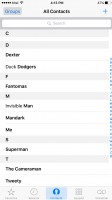



The phonebook
FaceTime is naturally available for all compatible iOS and Mac devices and allows you to make free voice and video calls to any other FaceTime-enabled device.
The same goes for iMessage - once enabled you can send free text and multimedia content, including voice-recorded messages, to any other iMessage-enabled Apple gadget.
FaceTime • iMessages
Apple is also offering a new feature called Wi-Fi calling. If both parties support this service and it is on, the call won't be placed through the cellular network but the internet. This improves the audio quality and won't use your allotted monthly minutes.
As usual we've tested the loudspeaker performance of the new iPhone 6s Plus. It is worse than the speaker of its iPhone 6 Plus predecessor and is only good for a Below Average mark. The sound quality is very good though.
This means you should keep a close eye on your phone in noisy environments, or missing calls is a real possibility.
| Speakerphone test | Voice, dB | Ringing | Overall score | |
| 65.8 | 65.1 | 64.6 | Below Average | |
| 66.5 | 64.6 | 65.8 | Below Average | |
| 67.3 | 65.7 | 66.5 | Below Average | |
| 65.8 | 64.8 | 70.4 | Average | |
| 66.5 | 65.8 | 70.5 | Average | |
| 65.3 | 64.6 | 73.5 | Average | |
| 66.6 | 65.7 | 72.8 | Average | |
| 66.7 | 65.7 | 75.7 | Good | |
| 68.1 | 66.3 | 73.7 | Good | |
| 68.7 | 66.5 | 76.2 | Good | |
| 66.9 | 71.8 | 74.7 | Good | |
| 72.0 | 66.6 | 77.5 | Good | |
| 71.3 | 73.8 | 79.9 | Very Good | |
| 73.7 | 72.8 | 79.9 | Very Good | |
| 75.7 | 73.5 | 79.5 | Excellent | |
| 75.7 | 73.5 | 80.7 | Excellent |
The messaging interface is kept the same since the iOS 8. It's 3D Touch-enhanced and you can get quick preview of your threads upon a firm press. The Mail app hasn't changed much, too, aside from the added force touch support and the new contextual menu with quick shortcuts for reply, forward, delete.
The Messaging app
Finally, the iOS 9 keyboard looks the same though its QuickType predictive input has got a refined algorithm. Over time, the iOS will learn from your typing patterns, vocabulary, people you write often to and topics. It will eventually understand the subject of each thread and base suggestions on whether the communication is formal or casual.



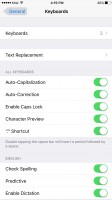

Apple iOS keyboard
Photos offers better search, 3D Touch support, Live Photos
The Photos app offers the same layout and interface we met for the first time in the iOS 8. Your pictures are organized by date and location, if available. The views you can switch between are Moments, Collections and Year - just like before.




Photos app
Recently Deleted album is available in case you change your mind in the next 30 days.
The Search options in the Photos app has been improved with the option to search by location and date. And this applies not only for the Photos app itself, but Siri as well. That's really useful for those with lots and lots of photos on their devices.
What's a Live Photo? This is an option enabled by default in the camera app and shoots a small video clip (3 seconds) a 1.5s before and a 1.5s after you hit the shutter. We've already seen this on the HTC One and the Zoe feature and they are pretty neat, allowing you keep more lively memories.
We already mentioned the 3D Touch support. It allows you to preview both standard photos and Live Photos in the gallery. It's a pop-up with the picture and you can swipe it up for additional settings (Copy, Share, Delete).




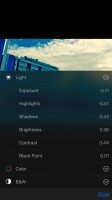
3D Touch • Image editing
The integrated image editor is really powerful and could improve your photos a lot. You should try and play a bit with it, it's among the best we've seen on a mobile device and while it may offer lots of manual tweaks, its automatic enhancement options are rather good, too.
Limited video player
Unfortunately iOS9 still hasn't done anything about the video player. You can upload only supported formats via iTunes or purchase videos from the iTunes store. This is an extremely disappointing showing by a platform that is supposed to excel at multimedia consumption.The lack of extra functionality is bad enough, but having to use just an extremely limited number of media format or resorting to converting files, which is both slow and inconvenient, is a real deal-breaker.



The video player
Luckily there are many powerful video apps in the App Store, so you shouldn't worry that your iPhone can't be a powerful video player. With the right app, it does everything you'd expect a normal device would do - play any kind of videos, with subtitles, and you can even cast it on an external display.
Music with Apple Music support
The iOS 9 music player looks a lot like the one from iOS 8 - it supports (ad-supported or ad-free) iTunes Radio and iTunes Match, as well as iCloud Music library. It syncs with your computer's iTunes library, streams from your Match and/or iCloud songs, as well.




The Music app with Apple Music
But in case that is not enough, there's also Apple Music now. The service can replace everything music-related feature Apple has launched to date and offer you pretty much the entire music world at the tip of your fingers.
Basically Apple Music does what Google Music or any other similar service does - allows you to stream songs, add them to playlists, and build an entire music library in the cloud. You can also download those songs for offline usage and unlike Google Music, Apple Music allows you to download single songs from albums.



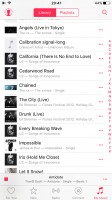
Beats 1 Radio • Connect with artists • My library
The search option is useful and there is a good chance you can find all of your favorite songs on Apple Music.
Apple knew it can't compete with Google Music, Spotify or Microsoft's Groove by just adding the same features, so it tries to bring you closer to your favorite artists. In addition to smart suggestions, you can follow your favorite musician and make sure you don't miss any important updates from them. Apple made it easier for both the stars and the users to share social content and that's probably the biggest advantage over the competition.
Finally, the Beats 1 radio is available 24/7 and the tracks there are chosen by real DJs, not machine algorithms. Lots of people have been hooked on this idea already.
Apple Music is priced differently in different regions and is accessible from more than 100 countries across the globe. It offers a three month long free trial, after which you have to pay between $2.99 (some Asian markets) and £9.99 (UK) depending on where you live. A $14.99/€14.99/€7.99 per month family plan is also available, and this works for up to 6 persons.
Audio output is mostly great, decently loud
The Apple iPhone 6s Plus results in our audio quality test matched those of its predecessor and its smaller iPhone 6s sibling. It did mostly excellent in the active external amplifier bit but its stereo crosstalk remained rather mediocre.The good news though is there's virtually no degradation when you plug in a pair of headphones. The spike in stereo crosstalk is so limited that in comparison, the iPhone 6s Plus fares way better here than in the first test.
In both cases, volume levels were just above average. Overall, the output is very good if not quite the best in the current market.
12MP is the new 8MP
The iPhone 6s Plus brings the long overdue camera resolution upgrade. After sticking to an 8MP sensor for four generations, Apple finally upgraded the iPhone's main camera to a 12MP imager. The front camera has received an upgrade to 5MP as well. Both cameras are paired with a lens with the same F/2.2 aperture.The more powerful chipset and the new 12MP sensor allow the iPhone 6s Plus to capture 4K video recording among other new modes, plus it enables the so-called Live Photos. This is a familiar feature from the first HTC One - the camera captures 1.5s video either side of the moment you hit the shutter and saves it as an animated photos.
There is no magic here, this is actually a 3s 1,440x1,080px (1,280x960px from the front camera) video with sound, captured at 14fps. We are clarifying this in case you've expected gifs or similar formats. Those small files are usually 3 to 4MB of size and if you own a 16GB iPhone 6s Plus, this may turn a problem for you rather quickly. The good news is this new format is compatible with the Mac OS X El Capitan and all Force-enabled Apple devices will support the Live Photos (for now those are the MacBook Pro 2015 models, the new MacBook 12" and the iPhone 6s duo).
The front camera, as we said, is now 5MP, supports Auto HDR, and 1080p video capture. It can also use the screen as 'Retina' flash - the screen lights up the moment you hit the Camera shutter, with brightness 300% higher than the usual maximum. This helps if you are shooting indoors and up close.
The front camera is fixed-focus, but you can control and lock the exposure setting with tap and hold.
The camera interface is the same as before. If you tap to focus the phone will give you control over exposure through a slider. This way you can conviniently adjust exposure compensation depending on the scene. You can lock the focus and exposure as well.
Along the left side of the camera viewfinder you'll find controls for switching to the front-facing camera, setting up a timer (either 3s or 10s), choosing the HDR mode (Auto, off and on), turning Live Photo on/off and a settings for the flash (Auto, on or off).
On the right side on each side of the virtual shutter button you get swipe controls that will take you into the photo, square and pano mode on one side and video, slow-mo and time-lapse. To activate the Burst mode you just need to press the camera shutter longer.



The camera UI
Despite taking four years to add a 12MP sensor, the shots snapped with the iPhone 6s aren't quite as impressive as we hoped. The resolved detail is good, but it's not dramatically better than what the iPhone 6 offered and post-processing is rather heavy-handed - as noticeable in the sharpening halos and the prominent noise. Automatic exposure is a bit too overeager, which at times results in overexposed shots.
Now the good news - the colors and contrast are great, while the dynamic range is simply great. We've turned the Auto HDR off and yet the images came out great, which is really something given the tough weather conditions.
If it were 2014 we might have considered the samples among the best in the market, but today with great Galaxy S6 generation cameras and the impressive Xperia Z5 sensors, we just can't rate the iPhone 6s Plus camera so high. It's good, but not quite the best.


Apple iPhone 6s Plus camera samples
We shot with the iPhone 6s Plus and archrival Galaxy S6 edge+ side by side, so you can compare the samples. The obvious difference in aspect ratio aside, there's no denying that the iPhone 6s Plus can't quite match the Galaxy S6 edge+ resolved detail.


Apple iPhone 6s Plus • Samsung Galaxy S6 edge+
We waited out for night to set in and took a couple of shots with both smartphones. The two have markedly different approaches with the S6 edge+ going for a much higher ISO (1250 in both shots) and faster shutter speed. The iPhone 6s Plus, on the other hand, chose a 1/4s shutter speed in both instances with ISO either 125 or 250.
The Galaxy images are noticeably brighter with more detail in the shadows, but also less defined light sources with a glow around them. The iPhone 6s Plus is less noisy, but keep in mind that the Galaxy S6 edge+ is shooting at ISO1250, so its images are quite good for such a high sensitivity. That said, the iPhone doesn't feel the need to crank the ISO so high, instead relying on the OIS, and indeed, there's no camera shake despite the rather long exposure.
In fit-to-screen magnifications the Galaxy images have an arguably more consumer-friendly rendition though, being brighter and with a little warmer colors.


Night shots: Apple iPhone 6s Plus • Samsung Galaxy S6 edge+
We tried a few HDR samples as well and they turned fine - they bring more detail in the shadows, without overexposing the highlights or sacrificing fine detail. It's a very subtle difference and while we appreciate the conservative approach, you may find yourself struggling to achieve that distinct HDR effect.
A nice touch is that you can set the iPhone to save a regular photo alongside the HDR one, so you can use the original should you choose to do so. That's perhaps part of the reason why the smartphone takes a brief moment of thought before you can shoot another image. It's nothing to be worried about as the camera is blazing fast to begin with.


iPhone 6s Plus HDR off/on • off/on
Finally, the iPhone 6s Plus, thanks to the bigger sensor, offers even bigger panoramic images. Those still cover about 180-degrees, but now they can go up to 15,000 x 4,000 pixels or 60MP. The stitching is great, there are no artefacts, the dynamic range is amazing, and the color rendering is good, too. Those didn't turn out over exposed as the still images and generally are among the best panoramas we've seen.

Apple iPhone 6s Plus panoramic sample
We snapped a 5MP picture with the front selfie camera, in case you are interested in its quality. The resolved detail isn't that high, but it's certainly an improvement over previous gen iPhones and will do just fine for the social networks.
You can see that the focus is fixed nearby, so distant backgrounds are quite blurry. It's obviously the right way to go though, as selfies are typically taken at arms length. That's been the thought behind the Retina flash feature, which lights up the display at up to 3 times its usual maximum brightness to illuminate selfies in dark settings. It also tailors the tint to match the ambient light. It's better than nothing and can save you in extreme cases, as long as you don't expect miracles.
Jika Anda menyukai Artikel di blog ini, Silahkan
klik disini untuk berlangganan gratis via email, dengan begitu Anda akan mendapat kiriman artikel setiap ada artikel yang terbit di Blog Sharing
